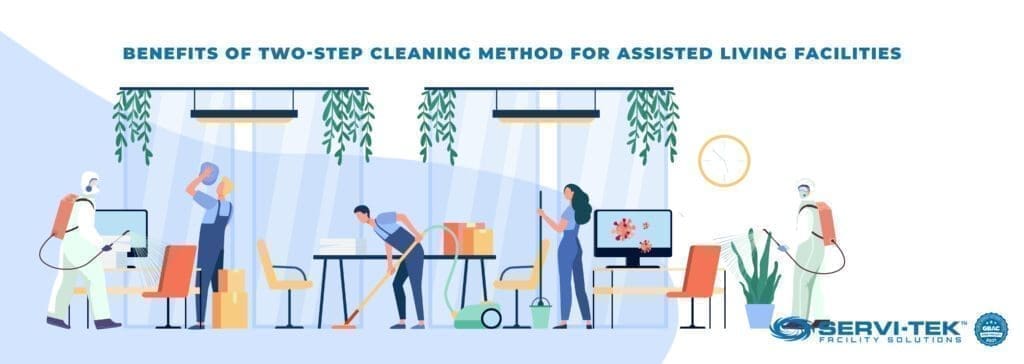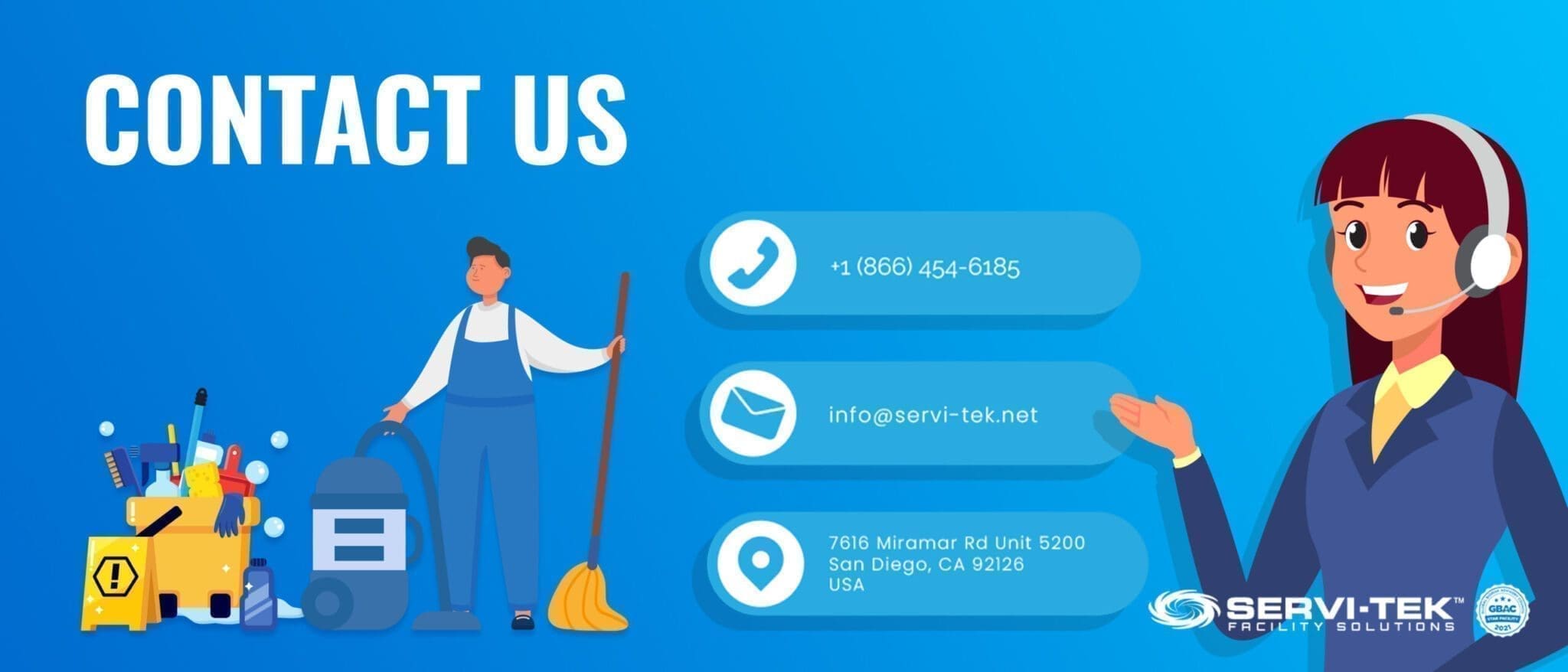According to the CDC, in the case of infectious diseases, the risk of developing severe symptoms increases with age. Unfortunately, many people continue to be unaware that the risk of severe illness is enhanced by underlying health conditions. Seniors in assisted living facilities and elder homes need to be given special care to protect them from contagious illnesses.
The first step to protect the elderly in assisted living facilities is to keep their living space clean, sanitized, and disinfected to prevent the spread of harmful germs.
However, this is easier said than done. There are several challenges to disinfecting long-term care settings. This post highlights these challenges and offers solutions to overcome them.
What is the Difference Between Cleaning and Disinfecting?

Whether you hire a commercial cleaning service or have an in-house cleaning team, you need to be aware of the difference between cleaning and disinfection. Cleaning simply means removing pathogens and dirt from a surface. This is usually done with the help of soap and water.
Disinfection is the process of killing pathogens, including harmful viruses and bacteria. This is achieved by using a chemical specially designed for that purpose. You need an ideal combination of cleaning and disinfection to keep your residents safe and protected from germs.
Keeping Assisted Living Facilities Germ Free

These are a few basic steps to ensure a contamination-free and clean facility. Different cleaning and disinfection methods need to be used for different areas as explained below:
Individual Suites and Rooms
There is a high chance that the vast majority of residents in your facility spend a lot of time in resident rooms and suites because of age and other concerns. The cleaning and disinfection staff should focus all their attention on the hard surfaces, including tables, chairs, bed frames, handles, door knobs, window frames, and ledges. They should also pay attention to the floor and entryway door.
You need to ensure that once the cleaning is performed, the cleaning crew makes use of the right disinfecting liquids. Electrostatic spraying has several advantages over regular disinfection methods. You shouldn’t forget blinds, curtains, remotes, laptops, and television sets. Coverings, such as coverlets, bed linens, pillows, and duvets should be laundered frequently, preferably with a disinfectant.
Bathrooms and Showers
Facilities should be cleaned at least once a day regardless of whether they are shared or used individually. All hard surfaces, such as light switches, clothing hooks, towel racks, toilet handles, toilets, handrails, door handles, showers, mirrors, window sills, bathtubs, shower heads, and faucets should be disinfected.
The floors and walls should be cleaned and disinfected thoroughly as well. You cannot expect a skilled nursing team to clean toilets or follow guidelines on using maintenance chemicals for the disinfection of residents. This is a job best left to commercial cleaners.
Common Areas
These areas include television rooms, sitting rooms, dining areas, communal areas, libraries, and other places in the facility where residents come in contact with each other. Areas that get a high amount of traffic are at the highest risk. In addition, you should focus on high-touch surfaces in these areas.
This includes remotes, handles, handrails, tables, door knobs, card tables, televisions, couches, settees, chairs, laptops, paper or magazine racks, vases, vending machines, picture frames, shelves, bookcases, exercise machines, window frames.
Food Preparation Areas/Kitchen
The majority of residents in assisted living communities and retirement homes have their food preparation areas and kitchens. These require special attention along with communal food preparation areas and kitchens. You need to ensure that the cleaning professionals clean all appliances, such as toasters, freezers, microwaves, stove tops, and dishwashers. They should pay attention to cabinets, light fixtures, food preparation surfaces, and pantries as well.
Safe Cleaning Products for Seniors
An easy-to-understand guideline has been published by the Centers for Disease Control (CDC) regarding cleaning and disinfection. These recommendations include a list of EPA-certified cleaning products that are safe and effective for use against SARS-CoV-2.
There are several familiar brand names on the list, including Lysol, Clorox, and Scrubbing Bubbles. In case you have an in-house cleaning team, you may want to keep these items stocked. The cleaners should be trained in their use as well. Using too much is not always recommended. At the same time, too little may not be effective.
Major Challenges in Disinfecting Assisted Living Facilities
Over 2 million Americans live in approximately 15,600 federally regulated nursing homes and 28,900 assisted living communities according to a report by the Centers for Disease Control and Prevention. You are leaving your facility open to catastrophic outcomes if you don’t take care to prevent the spread of infectious diseases and contaminants. You need to exercise every option in safety and health procedures to protect staff members and residents.
Glaring challenges faced by long-term care facilities when it comes to disinfection and infection control include a lack of specialized staff, limited human resources, and a safe environment that promotes socialization. Other factors that place residents at a high risk of infection include prolonged lengths of stay, weakened immune systems, impaired skin integrity, and indwelling medical devices.
The majority of these challenges can be solved by using the services of an experienced and professional commercial cleaning contractor. You need to ensure that they align with the policies of:
- Centers for Disease Control and Prevention (CDC)
- Association of periOperative Registered Nurses (AORN)
- Health Insurance Portability and Accountability Act of 1996 (HIPAA)
- Association for the Health Care Environment (AHE)
- Occupational Safety and Health Administration (OSHA)
- Centers for Medicare & Medicaid Services (CMS)
- Environmental Protection Agency (EPA)
Benefits of Two-Step Cleaning Method for Assisted Living Facilities

The two-step cleaning method is highly recommended for removing pathogens from a surface. This method removes the biofilm which harbors and feeds the pathogens as well. The first step is cleaning with a safe chemical to remove the soil and contaminants from the surface. Friction is used for dislodging trapped particles.
Disinfection is the second step and involves applying a disinfectant solution to the surface. The disinfectant must be allowed to remain for the recommended dwell time according to the manufacturer’s instructions. This will kill any remaining pathogens. It will also render other contaminants harmless.
Using an electrostatic sprayer regularly for disinfection has various uses. The disinfectant solution doesn’t need to be wiped away and is allowed to remain on the surface for a long time. This prevents other contaminants from adhering to the surface. The disinfecting chemical is turned to a fine mist while spraying which gets coated evenly on all surfaces. The mist envelopes object and can easily reach hard-to-clean areas.
The cleaners must choose solutions without any toxic ingredients to make them safer for senior residents.
Recommended Cleaning Frequencies in Assisted Living Facilities
It is difficult to create a cleaning schedule with optimum frequency for senior living facilities. This is because a cleaning schedule needs to take into consideration the residents:
- Independence
- Choice
- Privacy
- Dignity
- Individuality
It is important to maintain frequency in cleaning. However, it can be difficult to stick to a rigid cleaning schedule. Flexibility and willingness to work in unforeseen situations are important. The primary goal should be to serve the preferences and needs of the residents.
Common Items That Should be Given Special Attention

Certain personal items should be paid special attention to while cleaning and disinfecting. This includes:
- Landlines and cell phones: Phones come close to the face and can easily contain saliva. They should be properly wiped down with a disinfectant.
- Face masks: You may want to have all cloth face masks washed frequently if your facility still uses them
- Glasses: Prescription glasses and sunglasses can transfer germs from the hands to the face. These should be washed with a bar of dish soap.
- Wallets and purses: Germs can easily get transferred to a purse or wallet. Microfiber cloths or disinfectant wipes can be used for wiping down purses, wallets, and credit cards.
Tips to Overcome Disinfection Challenges in Assisted Living Facilities
These are a few tips that in-house cleaning staff can use for keeping common areas and resident areas clean and safe:
Scope of work: It is a good idea to establish a detailed scope of work for all workers
Focus on specific needs: Long-term care facilities can be home to germs, bacteria, and infectious diseases. You want to employ proper cleaning and disinfection methods.
Unique cleaning situations: The caregivers and cleaning staff should be prepared for accidental and unexpected cleaning situations
Frequency and schedules: It is vital to have a cleaning schedule in place so that nothing gets missed. Frequent cleaning is important as well.
Right cleaning products: You cannot disinfect a space by using all-purpose cleaning products. You may want to use products that can remove norovirus, methicillin-resistant Staphylococcus aureus (MRSA), and C. difficile.
Attention to high-touch areas: All high-touch surfaces and common areas should be given special consideration. Disinfecting them frequently will be able to prevent the spread of pathogens.
Soft surfaces: Cushions, curtains, and upholstered furniture is a breeding grounds for pathogens. It is your responsibility to not neglect these.
Get In Touch With an Experienced Commercial Cleaning Team
Servi-Tek strives to maintain a supportive and clean environment for residents in assisted living facilities. Our industry-leading processes, extensive knowledge, years of experience, and innovative equipment can help you keep your facility clean and contaminant free. We always deliver the highest standards of cleanliness every time because a task isn’t done until it is done properly. Give us a call at (866) 454-6185 or use our online form to get in touch with us.




